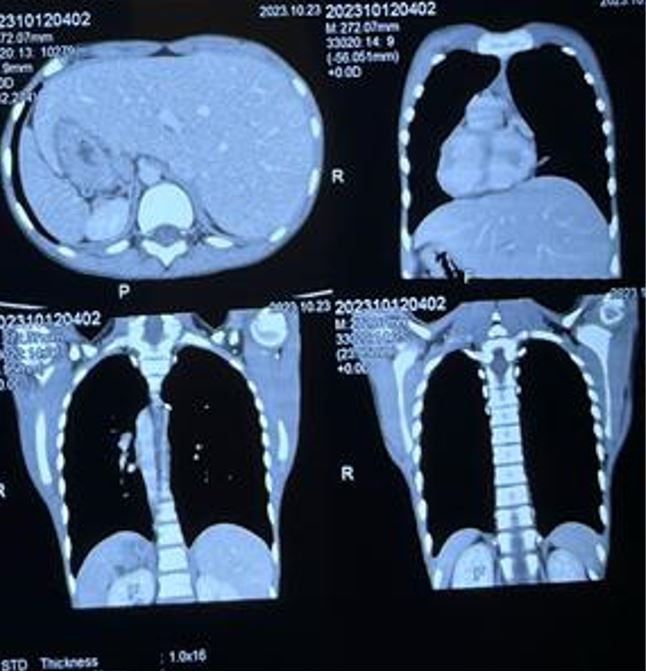Kartagener's syndrome with Dextrocardia - A case report
Abstract
One rare variant of immotile cilia syndrome is known as Kartagener's syndrome. The sinus, eustachian tube, middle ear, and respiratory tract cilia are all impacted by Kartagener syndrome. The inability or improper movement of these cilia causes persistent issues with the ear and sinuses. Some individuals with dextrocardia may not experience any symptoms, while others may have heart-related issues or other associated health problems. Diagnosis typically involves imaging studies such as X-rays, echocardiograms, or CT scans to visualize the position of the heart and other organs. Treatment depends on the presence of any associated heart defects or health issues. In many cases, individuals with dextrocardia can lead normal, healthy lives with proper medical management. Close collaboration between patients and healthcare providers is essential for individuals with dextrocardia to track their heart health and general wellness. Regular check-ups and appropriate medical interventions, if needed, can help manage any potential complications associated with this condition. Individuals with dextrocardia need to work closely with healthcare professionals to monitor their heart health and overall well-being. Regular check-ups and appropriate medical interventions, if needed, can help manage any potential complications associated with this condition.
Downloads
References
2. Skeik N, Jabr F. Kartagener syndrome. Int J Gen Med [Internet]. 2011;41. Available from: http://dx.doi.org/10.2147/ijgm.s16181
3. Webmd.com. [cited 2024 Mar 20]. Available from: https://www.webmd.com/children/what-is-kartagener-syndrome.
4. Tidy C. Kartagener’s syndrome [Internet]. Patient.info. [cited 2024 Mar 20]. Available from: https://patient.info/doctor/kartageners-syndrome
5. Kartagener M. Zur pathogenese der bronchiectasien. I Mitteilung:bronchiectasien bei situs viscerum inversus. Betr Klin Tuberk. 1933;83:498–501.
6. Channabasappa SM, Mohan HS, Sarma J. A patient with situs inversus totalis presenting for emergency laparoscopic appendectomy: Consideration for safe anesthetic management. Anesth Essays Res [Internet]. 2013;7(1):127–9. Available from: http://dx.doi.org/10.4103/0259-1162.114019
7. Leung AKC, Robson WLM. Dextrocardia with situs [corrected] solitus. CMAJ [Internet]. 2006;175(3):244. Available from: http://dx.doi.org/10.1503/cmaj.060721
8. Araoz PA, Reddy GP, Higgins CB. Congenital heart disease: morphology and function. Philadelphia, PA: Lippincott Williams & Wilkins; 2003.
9. Barthwal MS. Kartagener's syndrome in a fertile male - An uncommon variant. Lung India [Internet]. 2006;23(3):123. Available from: http://dx.doi.org/10.4103/0970-2113.44404
10. Dixit R, Dixit K, Jindal S, Shah KV. An unusual presentation of immotile-cilia syndrome with azoospermia: Case report and literature review. Lung India [Internet]. 2009;26(4):142–5. Available from: http://dx.doi.org/10.4103/0970-2113.56352
11. Afzelius B. Congenital immotile cilia--a rare syndrome of academic interest. An unexpected explanation is why the heart ends up on the left side. Lakartidningen. 2003;100(13):1148–9, 1152.
12. Maria Teresa Romero Rubio, Miguel Armengot Carceller, Carmen Carda Batalla, Amparo Escribano Montaner, Javier Milara Paya. What is the gold standard in the diagnosis of primary ciliary dyskinesia syndrome? Eur Respir J [Internet]. 2011;38(Suppl 55):512. Available from: http://erj.ersjournals.com/content/38/Suppl_55/p512.abstract
13. Fox CJ III, Keflemariam Y, Cornett EM, Urman RD, Rapoport Y, Shah B, et al. Structural heart issues in dextrocardia: Situs type matters. Ochsner J [Internet]. 2021;21(1):111–4. Available from: http://dx.doi.org/10.31486/toj.19.0119

Copyright (c) 2024 Author (s). Published by Siddharth Health Research and Social Welfare Society

This work is licensed under a Creative Commons Attribution 4.0 International License.


 OAI - Open Archives Initiative
OAI - Open Archives Initiative


